英语语法:分词构句
- 格式:docx
- 大小:14.33 KB
- 文档页数:3
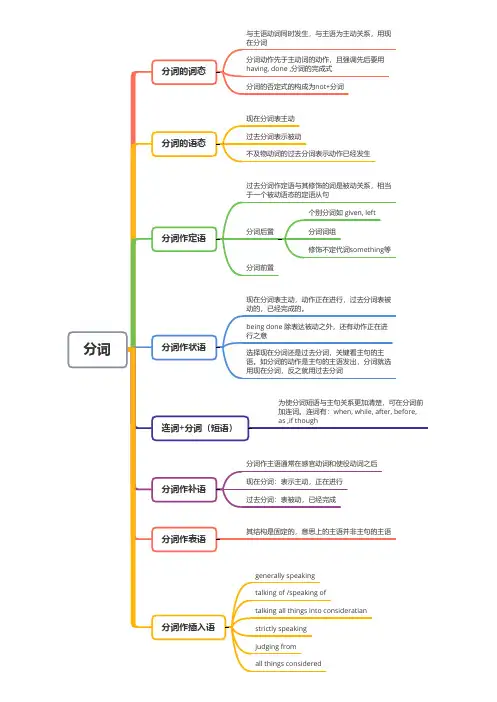
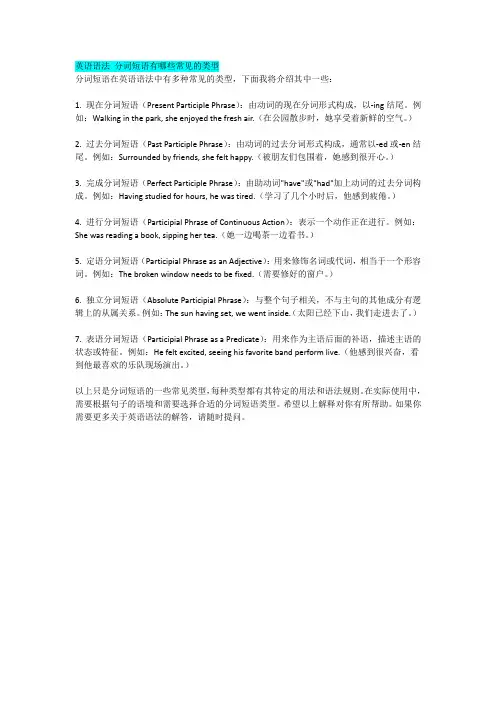
英语语法分词短语有哪些常见的类型分词短语在英语语法中有多种常见的类型,下面我将介绍其中一些:1. 现在分词短语(Present Participle Phrase):由动词的现在分词形式构成,以-ing结尾。
例如:Walking in the park, she enjoyed the fresh air.(在公园散步时,她享受着新鲜的空气。
)2. 过去分词短语(Past Participle Phrase):由动词的过去分词形式构成,通常以-ed或-en结尾。
例如:Surrounded by friends, she felt happy.(被朋友们包围着,她感到很开心。
)3. 完成分词短语(Perfect Participle Phrase):由助动词"have"或"had"加上动词的过去分词构成。
例如:Having studied for hours, he was tired.(学习了几个小时后,他感到疲倦。
)4. 进行分词短语(Participial Phrase of Continuous Action):表示一个动作正在进行。
例如:She was reading a book, sipping her tea.(她一边喝茶一边看书。
)5. 定语分词短语(Participial Phrase as an Adjective):用来修饰名词或代词,相当于一个形容词。
例如:The broken window needs to be fixed.(需要修好的窗户。
)6. 独立分词短语(Absolute Participial Phrase):与整个句子相关,不与主句的其他成分有逻辑上的从属关系。
例如:The sun having set, we went inside.(太阳已经下山,我们走进去了。
)7. 表语分词短语(Participial Phrase as a Predicate):用来作为主语后面的补语,描述主语的状态或特征。
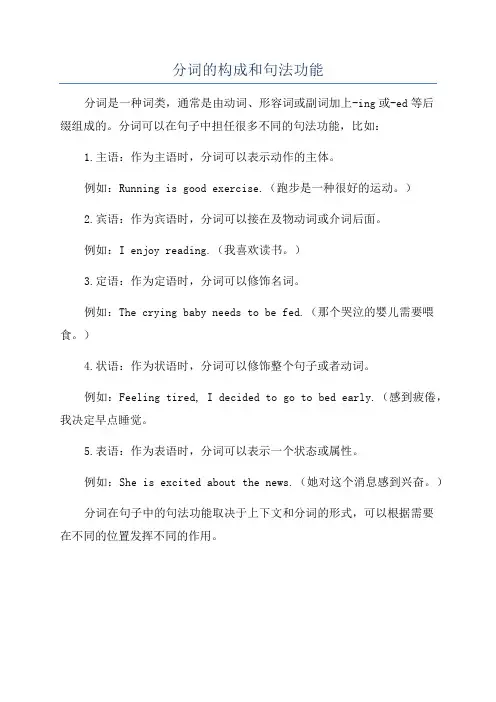
分词的构成和句法功能
分词是一种词类,通常是由动词、形容词或副词加上-ing或-ed等后
缀组成的。
分词可以在句子中担任很多不同的句法功能,比如:
1.主语:作为主语时,分词可以表示动作的主体。
例如:Running is good exercise.(跑步是一种很好的运动。
)
2.宾语:作为宾语时,分词可以接在及物动词或介词后面。
例如:I enjoy reading.(我喜欢读书。
)
3.定语:作为定语时,分词可以修饰名词。
例如:The crying baby needs to be fed.(那个哭泣的婴儿需要喂食。
)
4.状语:作为状语时,分词可以修饰整个句子或者动词。
例如:Feeling tired, I decided to go to bed early.(感到疲倦,我决定早点睡觉。
5.表语:作为表语时,分词可以表示一个状态或属性。
例如:She is excited about the news.(她对这个消息感到兴奋。
)分词在句子中的句法功能取决于上下文和分词的形式,可以根据需要
在不同的位置发挥不同的作用。
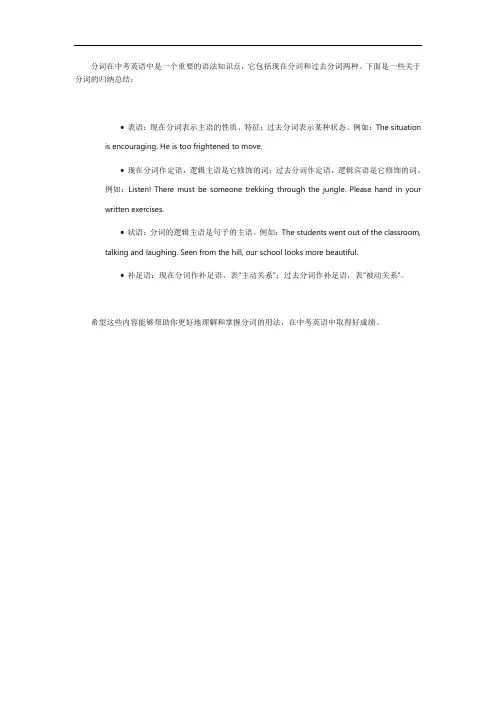
分词在中考英语中是一个重要的语法知识点,它包括现在分词和过去分词两种。
下面是一些关于分词的归纳总结:
•表语:现在分词表示主语的性质、特征;过去分词表示某种状态。
例如:The situation is encouraging. He is too frightened to move.
•现在分词作定语,逻辑主语是它修饰的词;过去分词作定语,逻辑宾语是它修饰的词。
例如:Listen! There must be someone trekking through the jungle. Please hand in your written exercises.
•状语:分词的逻辑主语是句子的主语。
例如:The students went out of the classroom, talking and laughing. Seen from the hill, our school looks more beautiful.
•补足语:现在分词作补足语,表“主动关系”;过去分词作补足语,表“被动关系”。
希望这些内容能够帮助你更好地理解和掌握分词的用法,在中考英语中取得好成绩。
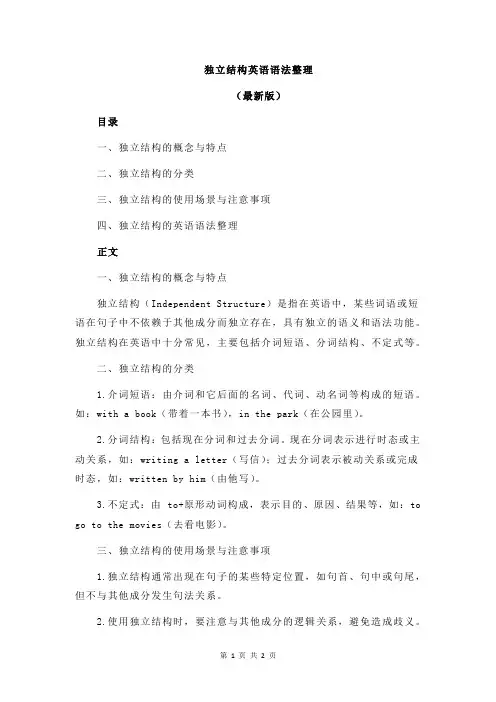
独立结构英语语法整理(最新版)目录一、独立结构的概念与特点二、独立结构的分类三、独立结构的使用场景与注意事项四、独立结构的英语语法整理正文一、独立结构的概念与特点独立结构(Independent Structure)是指在英语中,某些词语或短语在句子中不依赖于其他成分而独立存在,具有独立的语义和语法功能。
独立结构在英语中十分常见,主要包括介词短语、分词结构、不定式等。
二、独立结构的分类1.介词短语:由介词和它后面的名词、代词、动名词等构成的短语。
如:with a book(带着一本书),in the park(在公园里)。
2.分词结构:包括现在分词和过去分词。
现在分词表示进行时态或主动关系,如:writing a letter(写信);过去分词表示被动关系或完成时态,如:written by him(由他写)。
3.不定式:由 to+原形动词构成,表示目的、原因、结果等,如:to go to the movies(去看电影)。
三、独立结构的使用场景与注意事项1.独立结构通常出现在句子的某些特定位置,如句首、句中或句尾,但不与其他成分发生句法关系。
2.使用独立结构时,要注意与其他成分的逻辑关系,避免造成歧义。
3.在某些情况下,独立结构可以转换为其他语法结构,如分词结构可以转换为定语从句,不定式可以转换为名词从句等。
四、独立结构的英语语法整理1.介词短语:介词短语在句子中通常作状语,表示时间、地点、原因、目的等。
如:I saw her in the park yesterday(我昨天在公园里看到她)。
2.分词结构:分词结构在句子中可以作定语、状语或补语。
如:The book written by him is interesting(他写的书很有趣)。
3.不定式:不定式在句子中可以作目的状语、结果状语、原因状语等。
如:To learn English well, we need to practice more(为了学好英语,我们需要多练习)。
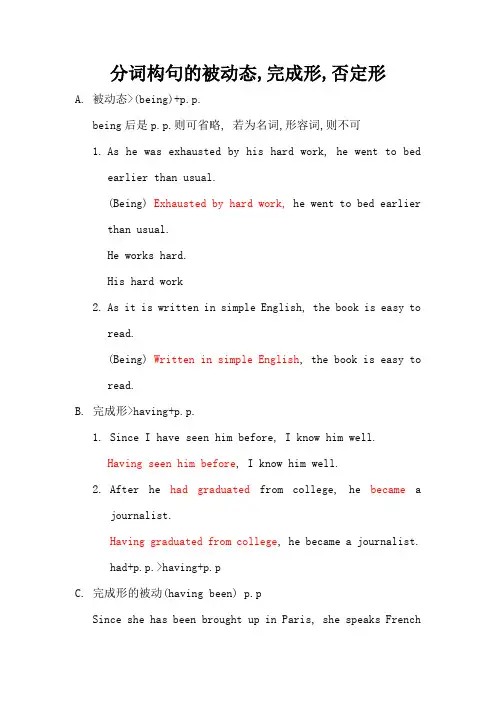
分词构句的被动态,完成形,否定形A.被动态>(being)+p.p.being后是p.p.则可省略, 若为名词,形容词,则不可1.As he was exhausted by his hard work, he went to bedearlier than usual.(Being) Exhausted by hard work, he went to bed earlier than usual.He works hard.His hard work2.As it is written in simple English, the book is easy toread.(Being) Written in simple English, the book is easy to read.B.完成形>having+p.p.1.Since I have seen him before, I know him well.Having seen him before, I know him well.2.After he had graduated from college, he became ajournalist.Having graduated from college, he became a journalist.had+p.p.>having+p.pC.完成形的被动(having been) p.pSince she has been brought up in Paris, she speaks Frenchvery.(Having been) Brought up in Paris, she speaks French very.分词构句是附属,并不注重时态,但要明确主被动D.否定形not/never+Ving or not/never+having+p.p1.As the teacher didn’t hear the bell, the teacher kepton teaching.Not hearing the bell, the teacher kept on teaching.2.Because he had not done his homework, he felt uneasy.Not having done his homework, he felt uneasy.。
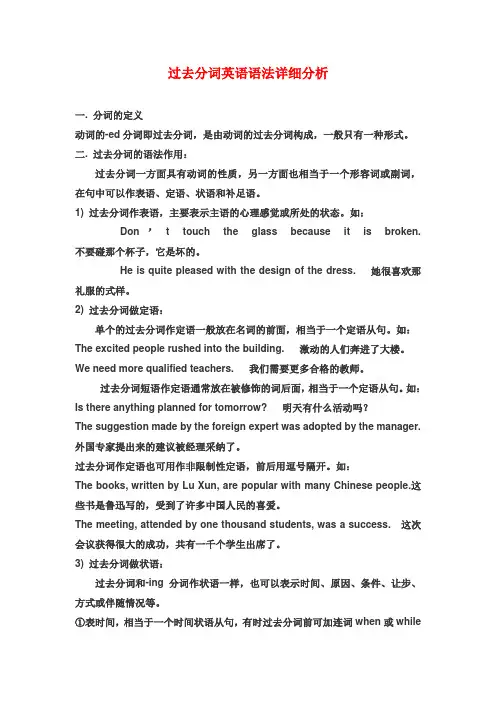
过去分词英语语法详细分析一. 分词的定义动词的-ed分词即过去分词,是由动词的过去分词构成,一般只有一种形式。
二. 过去分词的语法作用:过去分词一方面具有动词的性质,另一方面也相当于一个形容词或副词,在句中可以作表语、定语、状语和补足语。
1) 过去分词作表语,主要表示主语的心理感觉或所处的状态。
如:Don’t touch the glass because it is broken. 不要碰那个杯子,它是坏的。
He is quite pleased with the design of the dress. 她很喜欢那礼服的式样。
2) 过去分词做定语:单个的过去分词作定语一般放在名词的前面,相当于一个定语从句。
如:The excited people rushed into the building. 激动的人们奔进了大楼。
We need more qualified teachers. 我们需要更多合格的教师。
过去分词短语作定语通常放在被修饰的词后面,相当于一个定语从句。
如:Is there anything planned for tomorrow? 明天有什么活动吗?The suggestion made by the foreign expert was adopted by the manager. 外国专家提出来的建议被经理采纳了。
过去分词作定语也可用作非限制性定语,前后用逗号隔开。
如:The books, written by Lu Xun, are popular with many Chinese people.这些书是鲁迅写的,受到了许多中国人民的喜爱。
The meeting, attended by one thousand students, was a success. 这次会议获得很大的成功,共有一千个学生出席了。
3) 过去分词做状语:过去分词和-ing分词作状语一样,也可以表示时间、原因、条件、让步、方式或伴随情况等。

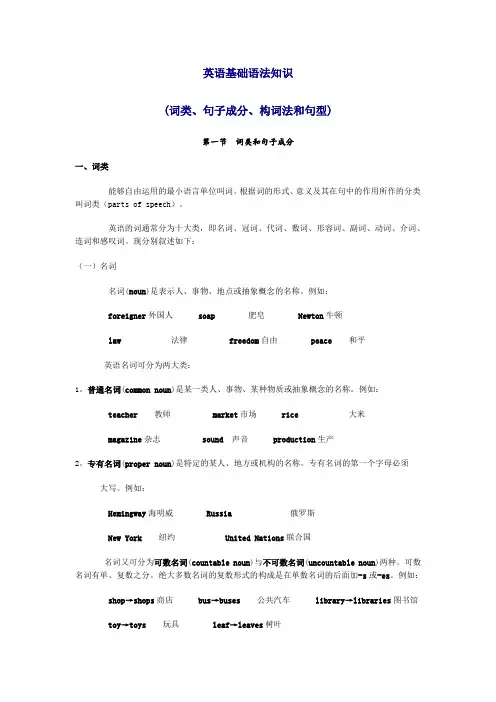
英语基础语法知识(词类、句子成分、构词法和句型)第一节词类和句子成分一、词类能够自由运用的最小语言单位叫词。
根据词的形式、意义及其在句中的作用所作的分类叫词类(parts of speech)。
英语的词通常分为十大类,即名词、冠词、代词、数词、形容词、副词、动词、介词、连词和感叹词。
现分别叙述如下:(一)名词名词(noun)是表示人、事物、地点或抽象概念的名称。
例如:foreigner外国人soap 肥皂Newton牛顿law 法律freedom自由peace和平英语名词可分为两大类:1。
普通名词(common noun)是某一类人、事物、某种物质或抽象概念的名称。
例如:teacher教师market市场rice大米magazine杂志sound声音production生产2。
专有名词(proper noun)是特定的某人、地方或机构的名称。
专有名词的第一个字母必须大写。
例如:Hemingway海明威Russia 俄罗斯New York 纽约United Nations联合国名词又可分为可数名词(countable noun)与不可数名词(uncountable noun)两种。
可数名词有单、复数之分。
绝大多数名词的复数形式的构成是在单数名词的后面加-s或-es。
例如:shop→shops商店bus→buses 公共汽车library→libraries图书馆toy→toys玩具leaf→leaves树叶英语中有一些名词的复数形式是不规则的。
例如:man→men男人tooth→teeth牙齿datum→data数据有关名词复数形式构成的具体规则,请参阅有关的英语语法书。
(二)冠词冠词(article)放在名词之前,帮助说明该名词所指的对象。
冠词分为不定冠词(indefinite article)和定冠词(definite article)两种。
不定冠词为a/an,用在单数名词之前,表示某一类人或事物的“一个”。
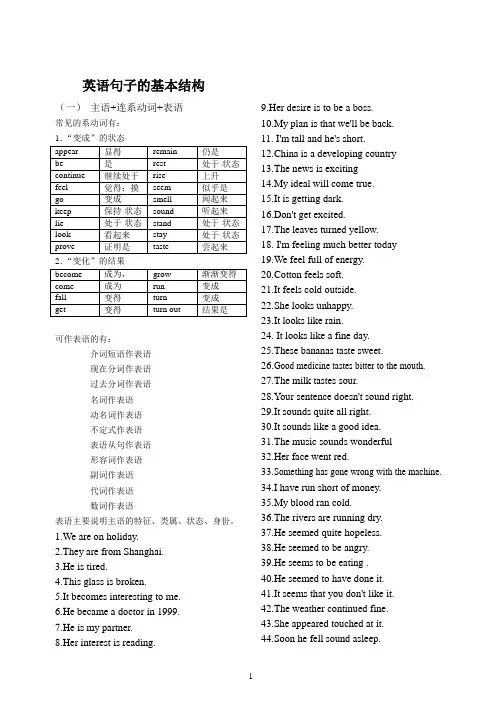
英语句子的基本结构(一)主语+连系动词+表语常见的系动词有:1.“变成”的状态2.“变化”的结果可作表语的有:介词短语作表语现在分词作表语过去分词作表语名词作表语动名词作表语不定式作表语表语从句作表语形容词作表语副词作表语代词作表语数词作表语表语主要说明主语的特征、类属、状态、身份。
1.We are on holiday.2.They are from Shanghai.3.He is tired.4.This glass is broken.5.It becomes interesting to me.6.He became a doctor in 1999.7.He is my partner.8.Her interest is reading. 9.Her desire is to be a boss.10.My plan is that we'll be back.11. I'm tall and he's short.12.China is a developing country13.The news is exciting14.My ideal will come true.15.It is getting dark.16.Don't get excited.17.The leaves turned yellow.18. I'm feeling much better today19.We feel full of energy.20.Cotton feels soft.21.It feels cold outside.22.She looks unhappy.23.It looks like rain.24. It looks like a fine day.25.These bananas taste sweet.26.Good medicine tastes bitter to the mouth.27.The milk tastes sour.28.Your sentence doesn't sound right.29.It sounds quite all right.30.It sounds like a good idea.31.The music sounds wonderful32.Her face went red.33.Something has gone wrong with the machine.34.I have run short of money.35.My blood ran cold.36.The rivers are running dry.37.He seemed quite hopeless.38.He seemed to be angry.39.He seems to be eating .40.He seemed to have done it.41.It seems that you don't like it.42.The weather continued fine.43.She appeared touched at it.44.Soon he fell sound asleep.45.She fell ill in bed that day.46.This method proved quite efficient.47The rumor proved ( to be ) false.48.He stayed single all his life.49The language stayed the same.50We should keep quiet in class.51He still remains poor.52.His English remains weak.53.We should remain modest.54.It turned out ( to be ) a fine day.55.Don’t they smell nice?56.The food smells nice.57.Is it done?58.Bob lay sick.59.The sun rose red.60.He stood still.61.This winter continued damp and wet.62.The shop stays open till 8 o’clock.63.We can’t rest east until they’re safely back.64.All the time she sat silent in the corner.(二)主语+谓语+状语(有时状语也可以提前,放在主语前面)可作状语的有:副词作状语介词短语作状语不定式短语作状语现在分词短语作状语过去分词短语作状语形容词短语作状语词组作状语复合结构作状语状语从句作状语名词作状语状语大都用来说明时间、地点、行为方式、程度、原因、目的、结果、条件、让步、比较或其它。

英语语法中的句子成分详解英语中的句子成分有主要成分和次要成分,对英语中的句子成分进行分析是英语语法中的重点。
下面店铺给大家分享的英语语法句子成分分析,希望能帮到你!句子成分的定义构成句子的各个部分叫做句子成分。
句子成分有主要成分和次要成分;主要成分有主语和谓语;次要成分有表语、宾语、定语、状语、补足语和同位语。
英语语法句子成分分析:主语主语是一个句子所叙述的主体,一般位于句首。
但在there be结构、疑问句(当主语不疑问词时)和倒装句中,主语位于谓语、助动词或情态动词后面。
主语可由名词、代词、数词、不定式、动名词、名词化的形容词和主语从句等表示。
例如:During the 1990s, American country music has become more and more popular.(名词)We often speak English in class.(代词)One-third of the students in this claare girls.(数词)To swim in the river is a great pleasure.(不定式)Smoking does harm to the health.(动名词)The rich should help the poor.(名词化的形容词)When we are going to have an English test has not been decided.(主语从句)It is necessary to master a foreign language.(it作形式主语,真正的主语为后面的`不定式)英语语法句子成分分析:谓语谓语说明主语所做的动作或具有的特征和状态。
动词在句中作谓语,一般放在主语之后。
谓语的构成如下:1、简单谓语:由一个动词或动词短语构成。
如:He practices running every morning.2、复合谓语:(1)由情态动词或其他助动词加动词原形构成。
英语语法什么是分词短语分词短语(Participle Phrase)是由动词的分词形式(现在分词或过去分词)构成的短语。
它可以作为形容词或副词,在句子中修饰名词、代词或动词。
分词短语能够提供更多的信息,丰富句子的描述和意义。
分词短语的形式如下:-现在分词形式(-ing形式):running, swimming, working等。
-过去分词形式(-ed形式):played, written, seen等。
下面是一些关于分词短语的常见用法和例子:1. 作为形容词修饰名词:分词短语可以用来描述或修饰名词,提供额外的信息。
例如:- The crying baby needs attention.(哭泣的婴儿需要关注。
)- The broken window should be fixed.(破碎的窗户应该修理。
)2. 作为形容词修饰代词:分词短语可以用来修饰代词,进一步描述代词所代表的人或物。
例如:- The man standing over there is my brother.(站在那里的那个人是我的兄弟。
)- I saw her running in the park.(我看见她在公园里跑步。
)3. 作为形容词修饰动词:分词短语可以用来修饰动词,提供动作进行时的描述。
例如:- He walked into the room, smiling happily.(他走进房间,脸上带着幸福的笑容。
)- She sang the song, her voice filled with emotion.(她唱着那首歌,声音中充满了情感。
)4. 作为副词修饰动词:分词短语可以用来修饰动词,提供动作的方式、原因、条件等信息。
例如:- He ran to catch the bus, hoping not to miss it.(他跑着去赶公交车,希望不要错过。
)- She studied hard, aiming to pass the exam.(她努力学习,目标是通过考试。
英语语法:谈谈分词的逻辑主语问题谈谈分词的逻辑主语问题一、什么是分词的逻辑主语分词属非谓语动词,即不用作谓语的动词,所以它没有真正的主语。
但是,分词作为动词的一种形式,它应有自己理论上或逻辑上的主语:I often hear him singing this song. 我经常听他唱这首歌。
(him 是singing的逻辑主语)Hearing the news, he couldn’t help crying. 听到这消息,他禁不住哭了。
(he是hearing的逻辑主语)若用的是过去分词或现在分词的被动式,则上面提到的逻辑主语实为“逻辑宾语”:I often hear this song sung. 我经常听到有人唱这首歌。
(this song是sung的逻辑主语,但是sing 的逻辑宾语)I saw her being taken to the operating room. 我看见她被送到手术室。
(her是being taken 的逻辑主语,但是take 的逻辑宾语)二、使用分词逻辑主语的易错点分词作状语,它的逻辑主语通常应是句子主语,否则会出错。
请看下例:(1) Finding her car stolen, ______.A. a policeman was asked to helpB. the area was searched thoroughlyC. it was looked for everywhereD. she hurried to a policeman for help此题答案应选D,因为句首用作状语的现在分词短语findingher car stolen 的逻辑主语应是“她”,而不是 a policeman, the area, it 等。
在使用分词的逻辑主语时还要注意根据句意判断是主动还是被动,如:(2) _____ many times, he still didn’t understand it.A. Having been toldB. Though to be toldC. Having toldD. He was told根据句意,he 与 tell 应是被动关系。
独立分词构句主词不同1.When the sun had set, we started for home. 启程回家The sun having set, we started for home.2.Because it was Sunday, the stores were all closed/all thestores were closed.It being Sunday, the stores were all closed.3.Because there was no bridge, we had to swim across theriver.There being no bridge, we had to swim across the river.must没有过去式,其过去式用had to 表现4.We’ll go on a picnic if the weather permits.We’ll go on a picnic, the weather permitting.picnic-picnickingwe’ll go on a picnic=we’ll picnic一. with+名词/代名词+分词用以表示附带状况1.I stood there with my heart beating violently. 主动2.The table was rather disorderly with several magazineslying open on it. 有几份杂志摊开在上面说谎 lie-lied-lied-lying躺,存在(vi.) lie-lay-lain-lying 不及物动词没有被动,故用lying, open是形容词母鸡下蛋,放置(vt.) lay-laid-laid-laying3.He came in with his boots covered in mud. 靴子上尽是泥巴4.He stood in front of us with his arms folded. 双手交叉。
分词构句
A.分词构句的形成
原则上,主要子句与分词构句主词一致
1.When I opened the door, I heard a strange sound.
Opening the door, I heard a strange sound.
主次相同,省略; 连接词视情况省略
2.As I was ill, I couldn’t go to school.
Being ill, I couldn’t go to school.
B.分词构句的含义
a.表时间
意指when, while等
1.Seeing the accident, she began to cry.
When she saw the accident, she began to cry.
2.Keeping him waiting outside, she did her shopping.
do shopping在买, go shopping逛逛而已
While she kept him waiting outside, she did her shopping.
b.表原因,理由
意指because, since, as等
1.Because he is a kind man, he is loved by everyone.
Being a kind man, he is loved by everyone.
2.Because I didn’t know what to say, I remained silent.
Not knowing what to say, I remained silent.
c.表附带状况
1.I ran all the way, and I arrived just in time.
I ran all the way,arriving just in time.
2.I washed the dishes as I listen to my favorite music.
I washed the dishes, listening to my favorite music.
d.表条件if
1.If you turn left after the bank, you will see our house
on you right.
If turning left after the bank, you will see our house on you right.
If 不可省
2.If you arrive earlier, you will have to wait for a
while.
If arriving earlier, you will have to wait for a while.
e.表让步though, although
1.Though I admit (that) you’re right, I still can’t
agree with you.
Admitting you’re right, I stil l can’t agree with you.
子音+元音+子音 >双写加ing
2.Although he lives near my house, he seldom comes to see
me.
Living near my house, he seldom comes to see me.
分词构句的位置
句首
Hearing the news, he got angry.
句中
Romeo, believing that Juliet was dead, decided to kill himself.
句尾
The teacher went out of the classroom, mumbling something.。